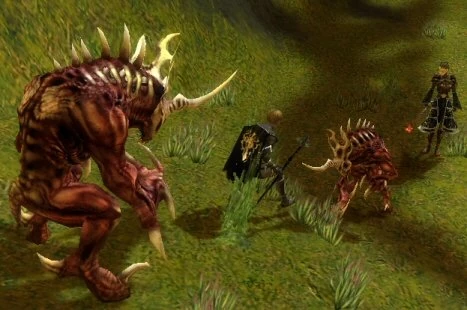Overview
Minions (a.k.a "Animated Undead" or "Animated Bones") are Undead servants animated by a Necromancer. A necromancer can exploit any nearby corpse to raise from it one or more undead minions. These minions are very handy as they follow their master closely and serve as tanks and cannon fodder. At high levels, they become formidable damage dealers in great numbers. Their biggest drawback is their constant health degeneration.
Minion Properties
There are six kinds of minions in the game:
- Core
- Prophecies Campaign
- Factions Campaign
- Flesh Golems
- Vampiric Horrors
- Celestial Horror (PvE only)
The following are some properties of minions:
- Like all undead they take double damage from Holy damage.
- A minion's level is dependant on caster's Death Magic attribute rank and minion type. Higher level minions have more health, greater armor, and stronger attacks.
- Minions are subject to constant health degeneration, starting at 1 "pip" of degen at summoning, and increasing by 1 pip of degeration every 20 seconds. (One pip of degeneration is -2 health per second.) While their actual health will never experience degeneration greater than -10 pips (20 health per second), they can have hidden degeneration greater than -10, if they have been "alive" long enough, that will counteract any regeneration from such skills as Verata's Sacrifice or Healing Breeze.
- Minions can be healed not only with necromancer spells like Verata's Sacrifice or Blood of the Master, but also with Monk spells like Heal Other, or Ritualist Restoration Magic. Contrary to some rumors, healing a minion with a Healing Prayers skill does not increase its degeneration.
- Friendly minions count as allies and may be the target of single-target and location-based spells that benefit allies.
- Minions do not count as party members and do not benefit from spells that target the casters entire party. These include Aegis, Heal Party, Order of Pain, and Order of the Vampire.
- Minions do not use pet AI. They do not neccessarily attack what their master attacks, and will attack any hostile creature that enters their agro circle. Similarly, they do not respond to called targets.
- A Necromancer can control only 2 minions with 0 points in his Death Attribute. Every two points after 0 allows control of another minion. As such a Necromancer can control up to 10 minions at Death 16. Thus, a secondary Necromancer can control only 8 minions.
- Raising minions requires a supply of corpses. An area empty of corpses, or that has creatures that do not leave corpses (like Golems), will greatly trouble a minion master.
- All minions do physical damage unless under the influence of another skill that alters damage types. See Greater Conflagration, Judge's Insight.
- When a minion dies, this will trigger the energy bonus from Soul Reaping, giving you part (or even all) of the energy cost as "refund".
- Beware of rangers spawning Spirits of Extinction, as these will usually kill all minions in the area in a chain reaction very quickly.
- A minion's level determines the size of a minion, as this picture shows:
Minion Health Degeneration
The effect of health degeneration is capped at 10, meaning that a minion will at most lose health at a rate of 10 health every 0.5 seconds. However, minion health degeneration will become increasingly difficult to counteract over time. This is because the total (raw, uncapped) degeneration rate can still increase beyond 10, and this is the value that regeneration effects (e.g. from Verata's Sacrifice and Healing Breeze) are calculated against.
If a minion's raw health degeneration has increased to -20 pips over time, the minion will suffer from -10 pips because of the degeneration cap. If Verata's Sacrifice is cast to give the minion +10 pips, the minion will experience -20 + 10 = -10 pips, which is the same as if Verata's Sacrifice had not been cast.
For additional information on animating, maintaining and combating minions, see General minion mastery guide
